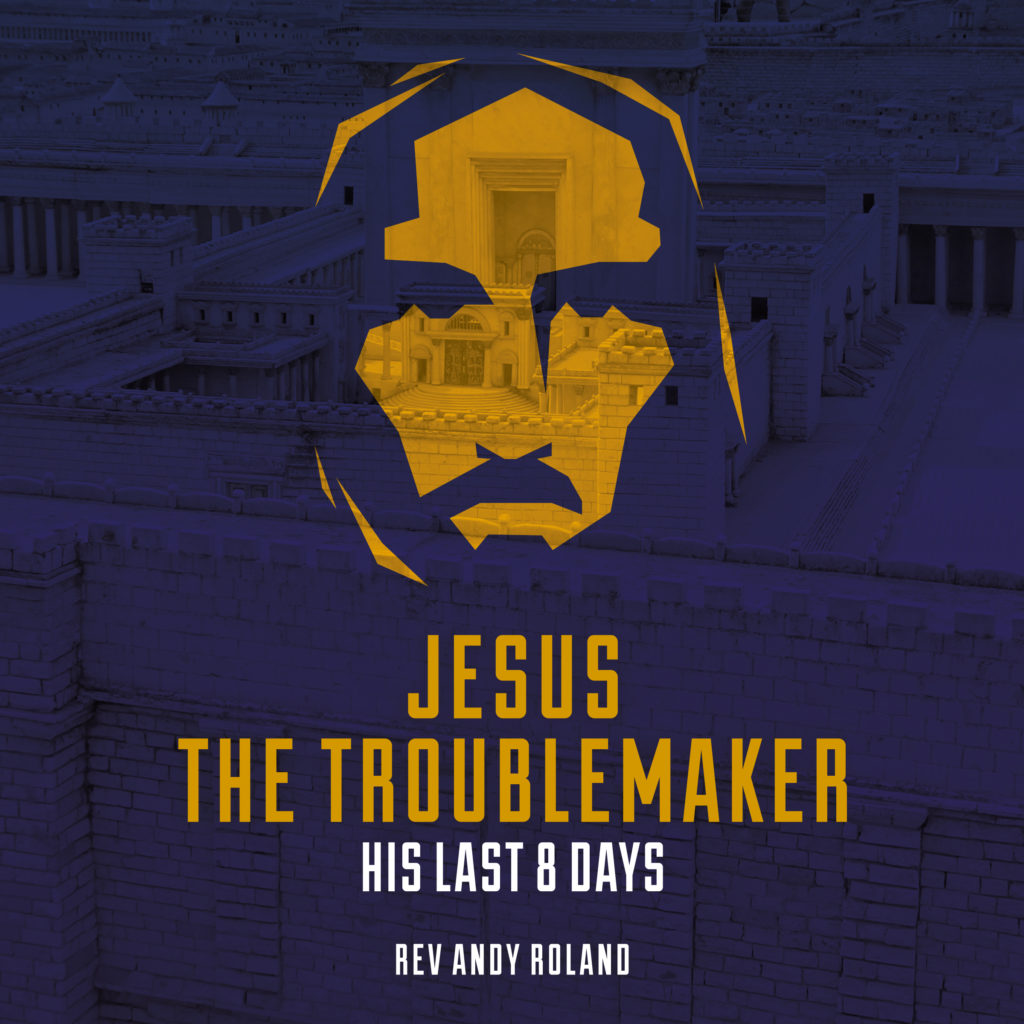
INTRODUCTION
On September 24th 2020 I started writing my historical novel ‘Jesus the Troublemaker’ and published it a year ago. It did not make my fortune! However, I learnt more about Jesus during Holy Week through writing a fictional account than I had through thirty years of preaching about him. Why did it have such a big impact and what did I learn?
LOCATION AND TIME
The amount of solid material for the last eight days of Jesus’ life is fantastic. And if you bring the words of Jesus up to date, he becomes a really vibrant figure. The gold standard for me is the Gospel of Mark, in my view written about 50 AD by the young man almost caught by the soldiers in Gethsemane (Mark 14.51-52). Luke for me is a reliable secondary source, written about 60 AD, while Paul was in prison in Caesarea (Acts 24.22-27) But what you don’t get in the gospels is an explanation of the constraints of time and place which were the framework of what we now call Holy Week. And reliable evidence is available.
My major source was the detailed model of 1st century Jerusalem which is now in the Israel Museum in Jerusalem. I have visited it seven times, the first occasion in the Holyland Hotel in West Jerusalem in 1964, when the Old City was out of bounds to anyone in Israel. The hotel owner had had it created as a substitute. By looking at it and consulting my photographs I could reconstruct Jesus’ daily movements.
Other sources were the fascinating book ‘The Temple’ by Alfred Edersheim (1875), the Jewish New Testament edited by David Sanders, and of course the internet and Wikipedia which answered innumerable questions such as: What is the temperature of Jericho in March? When is sunrise in Jerusalem in April? Who was Pontius Pilate? What is nard?
I could go on for ever detailing particular things I learnt about the last days of Jesus by writing ‘The Troublemaker’. Here I will talk about three things: Jesus and the Temple; the Last Supper and Gethsemane; and the trials of Jesus.
Note that Jesus was not his actual name. It was Yeshua. It turned into Jesus because Greeks could not write or pronounce the sound ‘sh’, and the ‘-us’ ending is just the standard Greek nominative form for masculine nouns. So – Yeshua, the Jewish rabbi from Galilee (Galilee = Galil ha Goyim, or Region of the Gentiles)
YESHUA AND THE TEMPLE
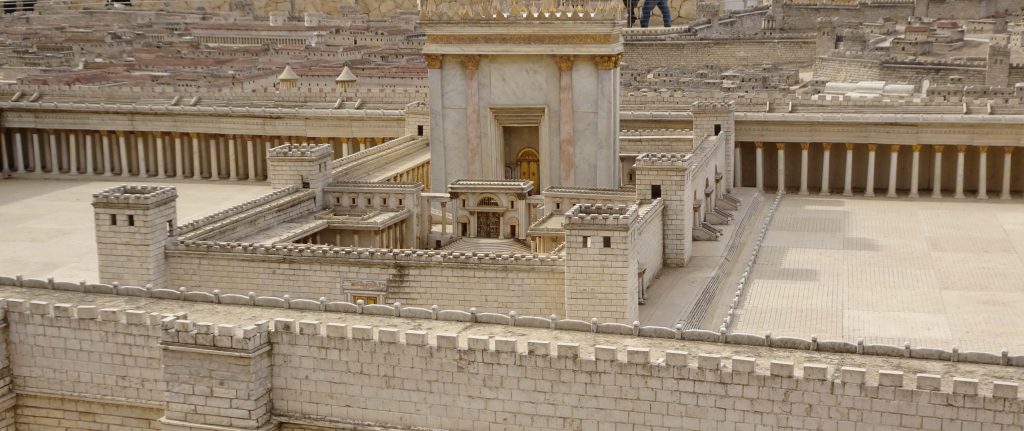
Matthew and Luke both say that Yeshua entered the Temple to ecstatic cheers from the crowd and instantly threw out the money-changer and animal traders. Mark tells us the real story: ‘(Yeshua) entered Jerusalem and went into the temple; and when he had looked around at everything, as it was already late, he went out to Bethany with the twelve.’ (Mark 11.11)
Why was he late?
Because he had just walked eighteen miles uphill from Jericho. If he had started out at daybreak, 6.00 a.m., he would have reached Bethany at 3.00. He then collected the colt/young horse and arrived at the Temple about the time of the evening sacrifice.
Why didn’t he make a 2-day journey of it?
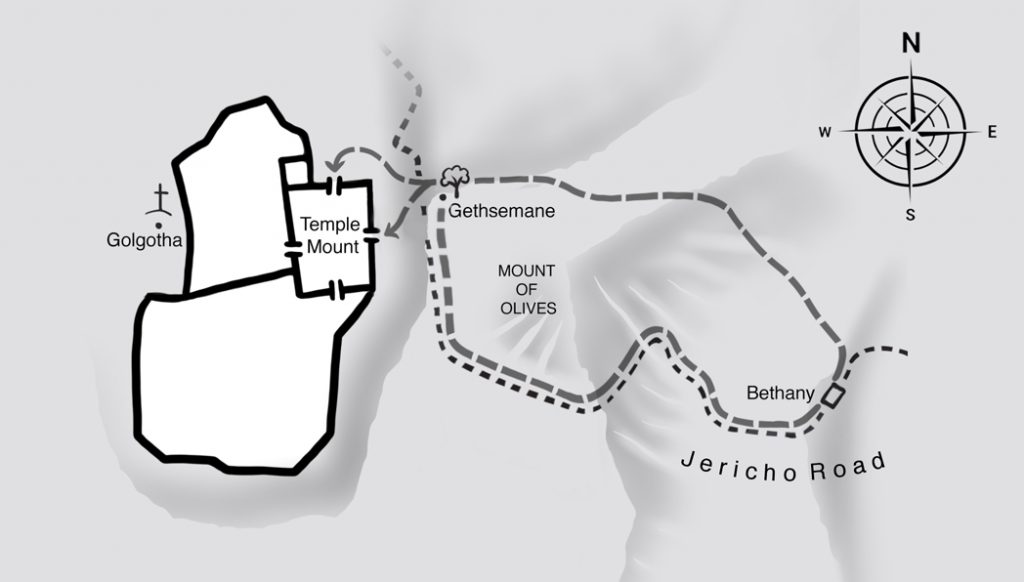
Because there was nothing along that road. No inns, no villages, no water. He had to do it in one go.
When he got to Bethany there were two possible routes. The steep ascent going straight to the city, and the more level longer one, better for carts. I suspect that Yeshua took the more direct way.
How big was the crowd of pilgrims?
If Yeshua had come in the morning, it would have been large, pilgrims streaming in to carry out their rituals of repentance and purification. But at 4.00? By then they would have been beginning to leave the Temple. My guess is that Yeshua picked up most of his supporters as they were leaving the Temple at the end off the afternoon. His entry would have been impressive but not overwhelmingly so.
Did this happen on Palm Sunday, like we celebrate it in church?
Possibly. But if John is right in having Mary anoint Jesus’ feet at supper ‘six days before Passover’, that would place the triumphal entry on Thursday. This is likely because pilgrims aimed to arrive at Jerusalem a full week before Passover in order to carry out the required rituals of repentance beforehand. I chose to keep to the traditional calendar of events as I would not then have two extra days to account for.
What did Yeshua do the next day?
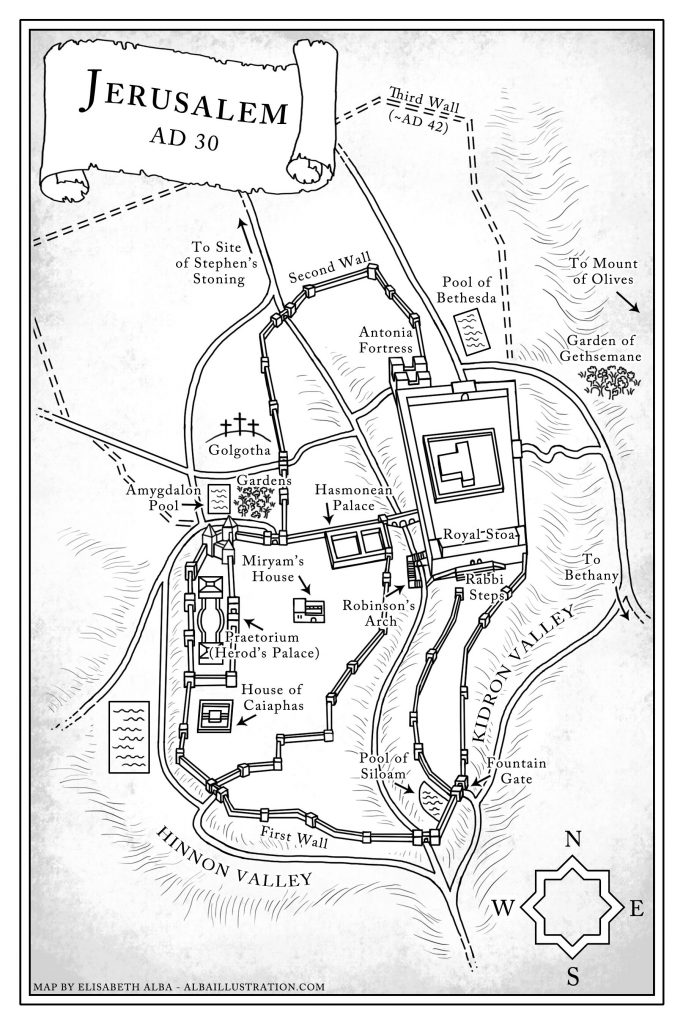
Mark tells us, ‘(Yeshua) entered the temple and began to drive out those who were selling and those who were buying in the temple, and he overturned the tables of the money-changers and the seats of those who sold doves; and he would not allow anyone to carry anything through the temple.’ (Mark 11.15-16)
For me the last ten words hold the key to everything that happened in Holy Week. The Temple was a vital thoroughfare for Jerusalem. The only gates leading directly to the east were through the Temple. For Jesus to stop all that traffic meant not just overturning a few tables. It meant having enough of his supporters, burly Galilean pilgrims, at each of the gates to outnumber the Temple guards. It was a forceful, and because well-planned, peaceful occupation. Which did not end after just one day. The following day members of the Sanhedrin asked Yeshua, “By what authority are you doing these things?’ (Mark 11.28). I guess that the Galilean occupation of the Temple lasted the rest of that week. No wonder t hat the Jewish powers-that-be were frantic to get rid of this troublemaker.
Where did they go?
The money-changers and animal dealers obviously wanted to continue trading. Where did they do that? Looking at the layout of Jerusalem in 30 AD, there were only two main possibilities. The money changers could have set up their tables outside the south gates of the Temple. The animal dealers would have done so outside the north gate, on the open ground between the Antonia fortress and the Pool of Bethesda, which is where they must have kept their animals overnight anyway. This area was not encircled by a wall until ten years later.
Making enemies
Yeshua’s action were very popular with the pilgrim crowd, but incredibly unpopular with the chief priests and Temple authorities. And also with the ordinary people of Jerusalem. They were the ones who suffered from the traffic jams and long ways round that traders now had to take. I guess that it was not hard for Caiaphas to organise a local hostile crowd to pressure Pilate to have Yeshua executed.
THE LAST SUPPER AND AFTER
Where did Yeshua hold the Last Supper?
There are two contenders. One is the Cenacle on the western Mount Zion, by the Dormition monastery. This was the only holy site that was in Israeli hands between 1948 and 1967. The other is the basement of the Syrian Orthodox chapel of St Mark in the heart of the Old City.
The Cenacle is a beautiful 12th century church, converted into a mosque, and is on all the standard pilgrim tours. It is built over a very ancient Christian site. There was a 4th century Byzantine church called the Church of the Apostles, with the tradition that that was where Yeshua held the Last Supper and where the Holy Spirit fell on the apostles at Pentecost. It was damaged in the 1948 war and subsequent investigations found that the lowest layer was the floor of a 1st century Jewish-Christian synagogue, with a niche, perhaps to keep the Torah scrolls, pointed not towards the Temple but towards the site of Golgotha and the empty tomb, now inside the Church of the Holy Sepulchre. The only problem is that it is on the ground floor, not an upper room, as specified in Mark 14.15.
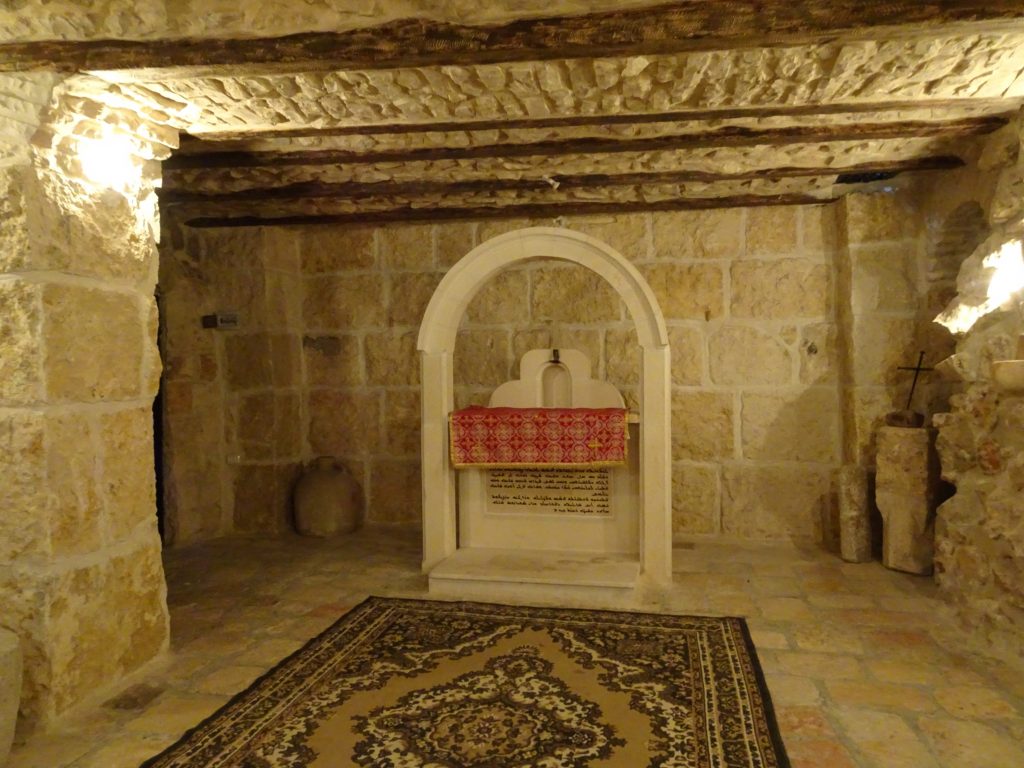
The other traditional site is the basement room of St Mark’s chapel. Since the ground level of the Old City has risen by about 30 feet in the last 2,000 years, this would make it a convincing candidate for the Upper Room. It is also in the heart of the 1st century Upper City, the wealthy half of Jerusalem, where two storey houses were common. It is a very plain room made of limestone blocks, but with a very strong spiritual presence. I went there with a fellow visitor to Jerusalem, and we just sat in silence for half an hour.
What did Yeshua do during the day?
Mark does not tell us what Yeshua did during the day. I assume that he spent the day in the Temple, teaching and talking in Solomon’s Portico, the double pillared colonnade running the length of the eastern wall. John 12 tells of a request made by some Gentile visitors that they might see Yeshua. That would fit. After the evening sacrifice, Yeshua would have gathered his disciples; obviously not in their normal meeting place of Gethsemane because that was in the opposite direction. My guess is that they met outside the Royal Porch, which led directly into the Upper City.
Where did Yeshua go after the meal?
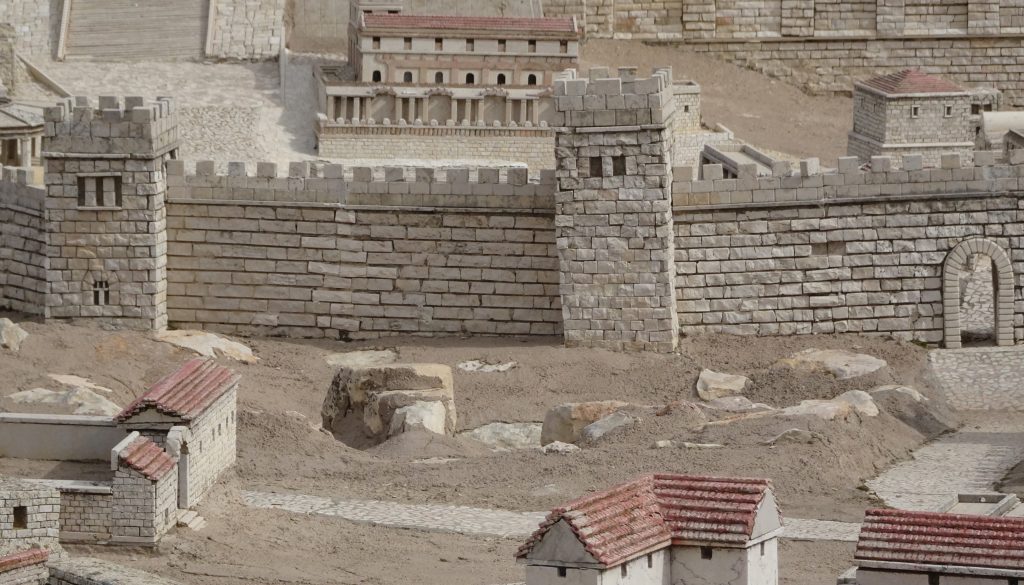
We know that after the Last Supper Yeshua went to Gethsemane, presumably to wait for Judas, or Y’hudah. As it was night, he could not take the direct route through the Temple, which would have been locked. By far the quickest way would be to take the northern route around the city, leaving by the main gate next to Herod’s palace, now the Roman headquarters, and following the city walls. This would have taken him to within a hundred yards of Golgotha, Skull Hill. In my imagination it was seeing in the moonlight the place where he was to die in agony eighteen hours later, that had Yeshua say, “You will all become deserters; for it is written, ‘I will strike the shepherd and the sheep will be scattered.’ But after I am raised up, I will go before you to Galilee.” (Mark 14.27-28)
HOW MANY TRIALS?
The Record of the Gospels
In church we celebrate the Last Supper on Maundy Thursday. On Good Friday we remember the crucifixion. But what happened between? And why do the gospels not agree between themselves? Here is what they say:
Mark 14 &15 Main trial before the high priest at night
Trial before Pilate in the morning.
Luke 22 & 23 Trial before the council in the morning.
First trial before Pilate
Trial before Herod
Second trial before Pilate
John 18 & 19 Night-time interrogation before former high priest Annas
(Imprisoned by Caiaphas, current high priest)
Trial before Pilate in public
Trial before Pilate in private
It all seems very confusing. Especially as there were two high priests, both appointed by the Roman prefect of the time: Annas, who had been official high priest from 6 to15 AD, and who probably died around 40 AD; and Caiaphas, Annas son-in-law who was official high priest from 18 to 36 AD. In Acts 4.6 Luke refers to ‘Annas the high priest, Caiaphas, John, and Alexander, and all who were of the high-priestly family.’
The Question of Time
Three factors of time need to be kept in mind:
a) It was illegal to hold a trial by night.
b) Yeshua was arrested about 11.00 pm.
c) Daybreak came at 6.00, and Jesus was taken to Skull Hill at 9.00.
d) Once the decision had been made to arrest Yeshua, the authorities had to move fast to avoid a mass riot of tens of thousands of Galilean pilgrims. In Mark 14.2 the chief priests and scribes say, “Not during the festival, or there may be a riot among the people.”
In view of the above it is likely that the main Jewish trial under Caiaphas took place at daybreak on Friday and lasted an hour.
The Question of Location
1 The interrogation by Annas
When Jesus was arrested, the way back to Jerusalem went straight to the old Hasmonean palace, occupied by Annas. It makes sense that Annas held a preliminary investigation there late at night. The writer of John’s gospel is presumably the ‘disciple who was known to the high priest’. (John 18.15). So he was able to bring Simon Peter, or Shim’on Kefa, in with him. Mark tells us that Simon broke down and wept when he heard the second cock-crow. I like William Barclay’s suggestion that this was the bugle call marking each 3-hour section of the night watch. This would have meant Yeshua was held in Annas’ palace from midnight to 3.00 a.m., and was then sent down to Caiaphas’ palace. Archaeologists have recently found a dungeon within Caiaphas’ palace, where Yeshua could have been held until morning.
2 The trial under Caiaphas.
Was this held in the main council chamber of the Sanhedrin within the Temple, in the Hall of Uncut or Polished Stone? Or was it held in a smaller hall in Caiaphas’ palace which could hold a smaller number, 24 instead of 71. This was the legal quorum as recorded by the Mishnah two hundred years later. I favour the latter, because I think that Caiaphas would have wanted to keep tight control of the proceedings.
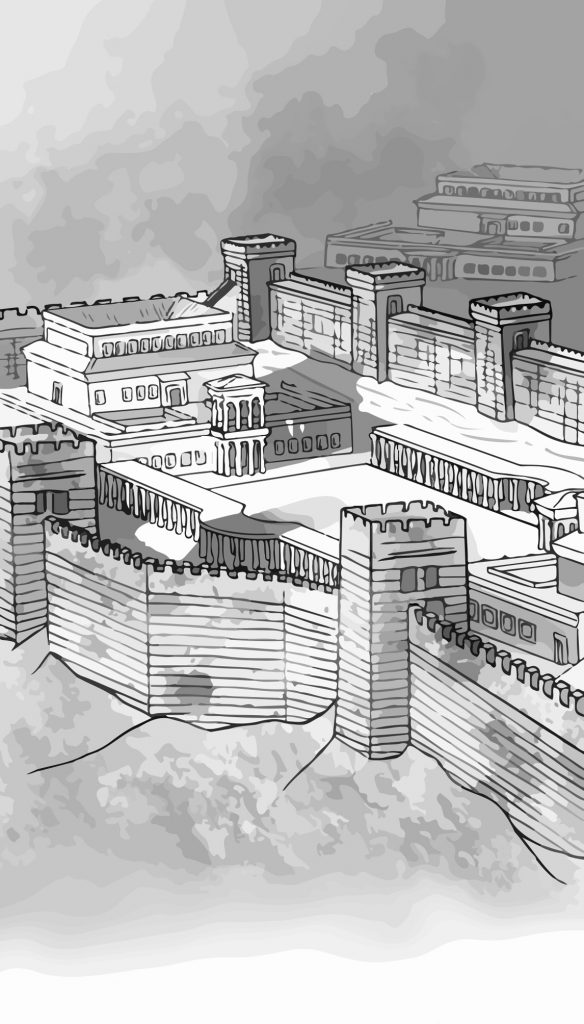
3 The Trial(s) under Pilate.
Where did Pilate interrogate Jesus? Some have opted for the Antonia fortress dominating the Temple. A much more likely spot is the northern half of Herod I’s enormous palace, a major barracks for Roman soldiers and the prefect’s headquarters whenever he was in Jerusalem. There was a large piazza in which a crowd could gather, and a balcony from which Pilate could address the crowd. John gives two words to describe the piazza: lithostratos and gabbatha. The first refers to the tessellated paving which decorated the pavement The other for means ‘raised’, and Herod did indeed build it fifteen feet above ground level.
Also, it was a five or ten minute walk from Caiaphas’ palace and another ten minutes to Golgotha or Skull Hill.
4 The Trial under Herod.
This is only mentioned in Luke and I always thought it unlikely because of the time constraints. But if Pilate’s interrogation was in part of Herod the Great’s palace, it makes perfect sense. Because Herod Antipas, the ruler of Galilee had been give the other half of the great palace in Jerusalem. To go from one wing to the other was simply a five minute walk. Perfectly do-able. And for Pilate an ideal way out of his dilemma of what to do with Yeshua. Herod had a track record in dealing with difficult prophets. After all he had neutralised John the Baptist.
Summary
With these locations in mind, here is how the events may have unfolded:
23.00 Yeshua arrested
24.00 Interrogation by Annas
03.00 Yeshua taken to Caiaphas
06.00 Trial under Caiaphas
07.30. First public trial under Pilate
08.00. Interrogation by Herod
08.30. Private interrogation by Pilate. The (Jerusalem) crowd demand crucifixion.
09.00. Crucifixion at Golgotha
The timing is tight but I think it is doable. What was in the mind of all the authorities was the urgent need for speed so that when the Galilean pilgrims arrived at the Temple in the morning they were faced with a fait accompli and matters did not end up with a bloodbath.
Above all I hope that I have shown the historicity of the main events of Holy Week, and that we can follow more imaginatively the last days of Yeshua, rabbi, prophet and even Messiah.
